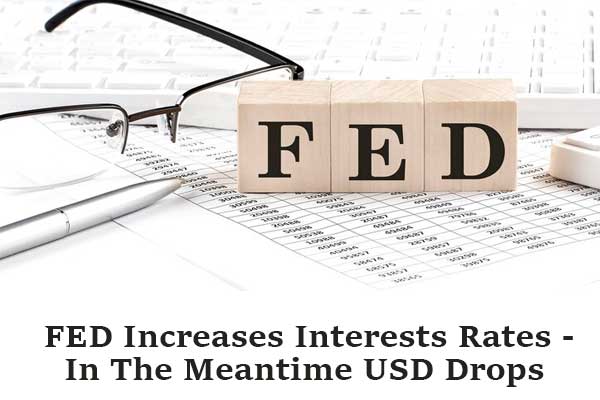It is the job of the Federal Reserve system to keep the US economy running smoothly— not too hot, but not too cold, as well. Inflation and asset bubbles may get out of control when the economy is booming and “running hot,” posing a danger to economic stability. Fed intervention comes in and boosts interest rates, which aids cool the economy down and maintaining growth.
When the federal funds rate changes, it may influence the value of the American dollar. Interest rates rise throughout the economy when the Federal Reserve raises the federal funds rate. Bond and interest-rate product investors from other countries are attracted by the greater yields.
This was the Federal Reserve’s third interest rate increase this year and the highest since 1994. The move is a response to the highest inflation rate in more than 40 years. Short-term federal funds rates rose to a range of 1.50 percent to 1.75 percent, and Fed officials projected that they would rise to 3.4 percent by the end of this year and to 3.8 percent by 2023. This is a significant shift from March projections, which predicted that the rate would rise to 1.9 percent by the end of 2015.
Officials from the United States’ central bank also hinted at a more rapid rise in borrowing rates shortly, aligning monetary policy with this week’s quick shift in financial industry views on how to limit price pressures.
Inflation Rate Skyrockets
According to the most recent figures, inflation in the United States reached a 40-year high in May, when consumer prices rose by 8.6 percent. In response to Russia’s invasion of Ukraine, gas, food, and most other products and services are increasing in price, especially at the pump. The COVID-19 epidemic has further increased supply chain challenges, which have resulted in the US’ highest annual rise since December 1981. With investors looking for safe havens due to the tightening of financial conditions, as written on the website of Axiory, the dollar has risen further in recent weeks as a result of the Federal Reserve boosting interest rates earlier than other major central banks. However, the dollar may not be able to gain much ground following the Fed’s decision because of the substantial interest rate hike already planned.
Inflation is Joe Biden’s main domestic issue, but he is discovering that he lacks the powers to directly affect prices. His popularity has taken a knock as a result. Biden has pushed Congress to take steps to decrease the prices of certain items while hammering home his hopeful message about the economic gains in the aftermath of the epidemic, including strong GDP growth and record job creation. Families in the United States are feeling the effects of skyrocketing prices for necessities like food, petrol, and rent, and are finding it more difficult to spend money on unnecessary products.
Following a surprise conference by the European Central Bank, which some traders anticipated might address the issue of fragmentation in the area, the dollar dropped versus the euro. Eurozone countries’ bond rates may rise significantly in certain countries notwithstanding economic fundamentals, which is known as the “fragmentation risk,” a term used by the European Central Bank (ECB).
What Are The Effects Of The Weakened USD?
For dollar-denominated safe-havens like US government bonds, the income they pay out has decreased in reaction to the US Federal Reserve’s loosening of monetary policy (actually and in the future). Emerging markets and Europe have seen a change in holdings as a result of the decline in the appeal of US assets.
If the currency continues to weaken, inflation in the United States will rise and stocks will fall. As a result, it is suggested that investors explore investing in non-U.S. stocks and commodities, which seem to have an opposite connection with the dollar and, as a result, are surging.
The stock market may suffer as a result of rising interest rates in the market. For both public and private enterprises, borrowing money becomes more costly when the Fed raises interest rates. Public companies’ revenues and profits might suffer if their growth rate and stock prices are slowed down as a result of rising expenses and a decline in activity.
Interest rate fluctuations have a significant impact on bond prices. When the Federal Reserve raises interest rates, current bond prices fall instantly. Investors will soon be able to take advantage of new bonds with higher interest rates that are set to be released into the market. Existing bonds’ prices will fall to reflect the higher average interest rates, making their lower monthly interest payments more tempting to investors.
The growing inflation component of the index indicates that the cost of products is increasing in the market. People’s buying power decreases if prices rise but salaries do not. Investors, too, are affected by inflation.
Foreign goods are cheaper when the dollar is high. When the euro is weak and the dollar is strong, imports from Europe to the United States are cheaper. The consequence is reduced pricing for American consumers, which in turn results in a lower rate of inflation in the United States.
The Federal Reserve plans to aggressively raise interest rates in the coming months to stabilize prices while preserving employment. Since the beginning of the year, the Federal Reserve has raised interest rates by 1.5 percentage points, placing its benchmark interest rate at a range of 1.5 to 1.75 percent.
The supply and demand for commodities, as well as the competitiveness of US agriculture, may be affected by short-term changes in the currency rate. Importers have to pay more for the US dollar to purchase US goods when the US currency strengthens or rises in value. Increasing import costs are offset by a decline in global demand for US goods as the US currency strengthens. It also lowers domestic pricing in the United States and increases the supply of domestically produced goods.
